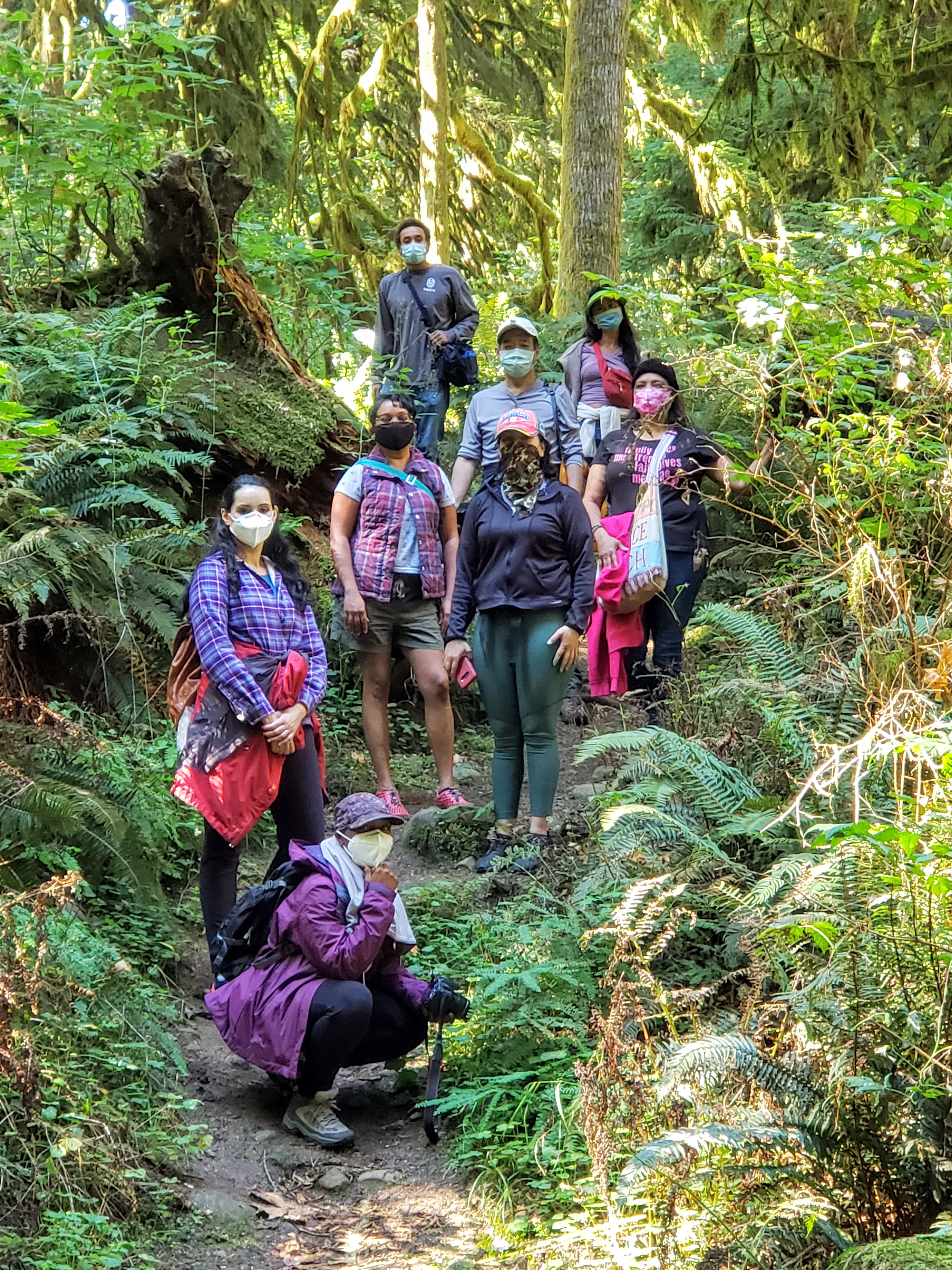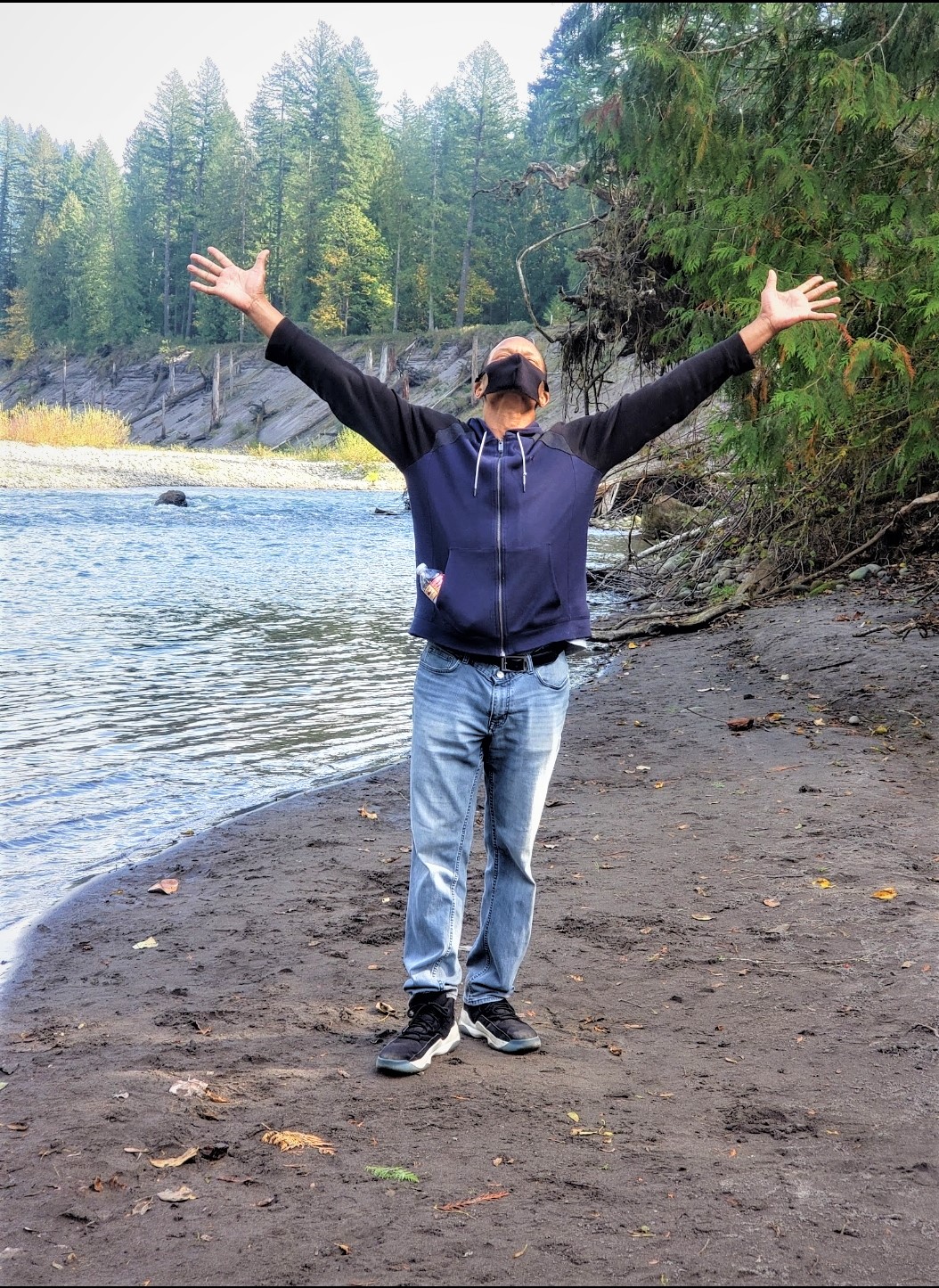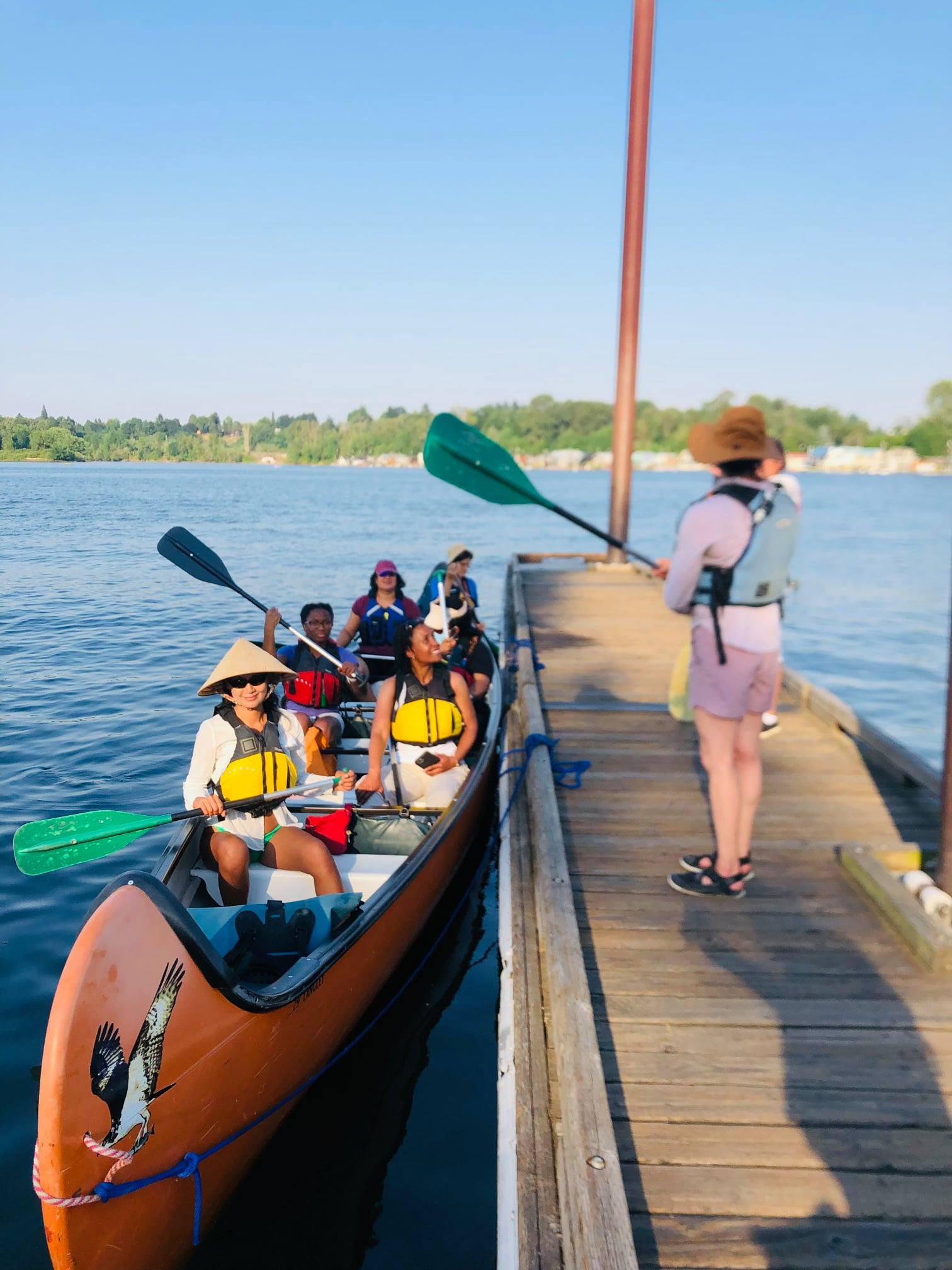
Enjoying the many national parks that are scattered across our country is one of our greatest and most cherished privileges. The ability to connect with nature is absolutely vital to the human experience. But when you’re a person of color, that can be easier said than done. Last year, the internet got a small dose of the kind bullshit people of color have to deal with while out in nature — Christian Cooper and the Central Park Karen. And that’s merely one example of the disparity BIPOC face when spending time in outdoor spaces, one which only received attention because it was caught on camera.
Pamela Slaughter, the founder of the Portland-based non-profit People Of Color Outdoors (POCO), is trying to address that disparity.
“Our mission at POCO is to help Black, Indigenous and Poeple of Color deepen their natural connection with nature,” she says. “We’re a mixture of ‘Outdoors 101’ and ‘Welcome To Oregon,’ for BIPOC. Most of our members are looking to experience their firsts with us. First hike, first overnight camping trip, first time birdwatching, forest bathing, and canoeing,”

Through community group organizing, POCO hopes to create a Portland that is more inclusive and safe for BIPOC. With their efforts, the city’s outdoor spaces feel more accessible than ever — a vital step for the city that topped our 2021 Uproxx Fall Experience Guide.
“Generations of people of color have become disconnected from nature due to displacement, environmental pollution and destruction, and exclusion. As a result, there’s a lack of internal wellness in the community that can be at least partially healed by reconnecting with nature. POCO intends to help facilitate the connection,” writes Slaughter in a recent blog post.
To help new hikers and recent Portland transplants fall in love with the bounty of great outdoor spaces in the area, Slaughter hit us with her eight favorite city hikes that offer an inclusive experience that’s both welcoming to beginners and experienced hikers alike. Let’s dive in.
Portland Audubon Wildlife Sanctuary
We love the Audubon Society Sanctuary! It’s a wonderful place to go whether you have 20 minutes or two hours. There is a Welcome/Information Center on the west side of the parking lot, and the Wildlife Clinic on the east side. There is a covered walkway with some seating in between. Be sure to start the visit with a stop at the Welcome Center. There, you can see a map that will light up each individual trail, which makes it easy to compare and choose which one to hike. Most will take you past some old growth trees, streams, and over a couple of bridges.
This is a wildlife sanctuary, so dogs are not allowed. The average active first grader can walk any of the trails. The pond and its covered gazebo are temporarily closed. In the springtime, children are delighted to see dozens of newts swimming in the pond. In the summertime, there are lots of frogs. There are stairs leading down to a steep incline that leads to a steep trail.
The entryway to the sanctuary starts at the bottom of the steep trail. This is not a walk for anyone that has trouble balancing.
Whitaker Ponds Nature Park — Whitaker Ponds Loop Hike
I personally visit Whitaker Ponds about three times a week, because I drive by it a lot in my other career as a realtor. It’s a 22-acre nature park that borders the Columbia Slough and has two ponds. There is a ½ mile path that loops around the west pond, and several scenic places to stop and bird watch…
Bring your binoculars! We’ve spotted herons, egrets, woodpeckers, and all manner of ducks and geese. We’ve spotted bunnies, muskrats, and otters, and we see fresh evidence of beavers every day. There is a dock for kayakers and canoeists that want to explore the slough. There is no recreation allowed on the ponds. There is a porta-potty that is cleaned frequently by the City of Portland Parks Department, and a gazebo with tables and benches, so bring your tablecloth, wipes, food, and garbage bag and have a picnic, too!
Leach Botanical Gardens
Leach Botanical Gardens is a magical place. Children always end up talking about fairies when they visit. Every time. I’m serious. That is because the manor house (yes, there is a manor house) looks like a magical cottage when viewed from the stunning aerial bridge that lets visitors walk among the treetops. It still looks like a magical cottage when viewed from the valley past the manor house, where Johnson Creek rushes by. This garden is host to an immense variety of plants from all over the world, thanks to the former owners. There is even a yet identified plant growing on the property.
One thing that makes Leach Botanical Gardens special to BIPOC is that Charles Jordan, the first Black City Commissioner of Parks, stopped the property from being released by the city to be sold. Before signing off on the release, Mr. Jordan visited the property. After seeing the spectacular 16 acres with its 1000+ species of plants, original cottage, manor house, and gardens, Mr. Jordan decided that the City should acquire and treasure the property.
We in Portland will be forever grateful.
Columbia Children’s Arboretum — Children’s Arboretum Loop Hike
This is another easy, lovely walk. (My job is to create love, not sweat, remember?) This is a 22-acre park that is mostly flat and either paved or hard packed. The walk is a loop that takes you past the Columbia Slough, and little waterways here and there. This is a place where you can see deer early in the morning or at dusk.
Children planted most of the trees in this arboretum, hence the name. There are gorgeous trees from all over the world. You’ll see all kinds of birds here, too. It’s another sweet green retreat sitting blocks away from the bustling city.
Oxbow Regional Park — Oxbow Loop
POCO has at least four outings at Oxbow Park per year. Whether you hike an easy two miles (POCO’s typical hike) or the 7.9-mile loop, here’s what you’re going to see: hundreds of towering, Douglas fir trees, western red cedars, and many other trees and shrubs. Most will be wearing a thick coat of velvety moss. Some wear it loosely draped and hanging off their branches. Others are wrapped in it from trunk to canopy, extending to the end of every branch.
You’ll see ferns. Thousands of them in various shades of green. They grow in the ground, on the trees, in the moss. You’ll see sword ferns, licorice, maidenhair, deer and others. There are more alders, cottonwoods and maples along the riverside parts of the trail. You’ll see birds of all kinds. You might see an osprey, kingfisher or eagle catch a fish in the summer. You might see spawning salmon in the fall. You’re likely to see deer all year round. This 1000-acre nature refuge doesn’t allow dogs.
Oxbow Park is very important to Indigenous people, and always has been. At one point, trees were being logged for timber. That practice was halted by Estella Ehelebe, the first Black Multnomah County Parks Superintendent. Because of her actions 50 years ago, there are still 92 acres of old growth and secondary old growth left at Oxbow. Spotted owls, elk, cougar, bear and other sensitive wildlife inhabit Oxbow, and there are a variety of trails to explore there. Overnight camping is available, too. Parking is $5 per visit, or $30 for an annual pass to all of Metro Parks, including Oxbow.
Tyron Creek State Park
Tryon Creek is a park with over 650 acres to explore. This park is unique because there are trails that can be accessed by hikers, horseback riders and there’s also a bicycle trail. POCO has always visited to hike, so far. There are short hikes, longer hikes, easy hikes, and moderate hikes. There is a map posted, a visitor center, and bathrooms. This is a beautiful park with streams flowing through it. There are mostly gentle slopes with some hillier trails, too.
The trails that feature bridges are some of the prettiest, but you’re more likely to spot birds and wildlife where trees are denser. There are stunning settings throughout the park, and each season holds its own special beauty. There is a fee for parking and in the summer parking is tight. The park is beautiful all year round, and dogs are allowed, on a leash.
Silver Falls State Park
Silver Falls State Park a wonderland of 10 different waterfalls. Some waterfalls are powerful and roar loudly as they tumble out over the drop-off with power and force. Others are more delicate, musical streams of silver dancing over stone and landing in soft splashes on the moss-covered boulders resting in the pool below. The loop to see all 10 falls is just under 7 miles and is moderately challenging.
This is a 9,000+ acre park, so there is a lot to do. There are gorgeous trails that take you past various falls. Children love Silver Falls because four of the falls take hikers directly behind the waterfall. You might get slightly damp, depending on the waterfall, but it’s a treat. There is a lodge, dining, campground, cabins for rent, horse camp, and bike trails. There is a $3 parking fee.
The lodging is often booked up months in advance, but nearby Silverton, OR hosts the Oregon Garden Resort, which includes admission to the Oregon Garden, another place POCO enjoys visiting.
Forest Park
Forest Park is a 5,200-acre city park. It is bordered by the Audubon Sanctuary, so POCO outings sometimes include spending a little time at both locations. Forest Park is exactly that – a forest inside of the city. There are heavily hiked areas and areas where you can hike for 45 minutes and not see another person. There are parts of the park where there are acres of hills and fields.
Elk herds like to hang out there. There are deer in the forest, cougar, bear, owls, caught on webcams, though rarely seen. Balch creek flows through the Audubon Sanctuary and Forest Park. Balch Creek trout have become landlocked there and have adapted to living in the shallow creek. The trout there can only be found at Balch Creek. POCO was fortunate enough to have some amazing BIPOC park rangers guide us at Forest Park, such as Dave Barrios, an Indigenous ranger that taught us the way to get the elusive trout to come out of hiding. A Black ranger (now a supervisor) Vicente Harrison gave copies of his book, “My Nature Exploration”, to children as a reward for spotting and identifying birds. There are a variety of trails to see but be sure to include the trail that walks past the old stone cottage when you visit.


